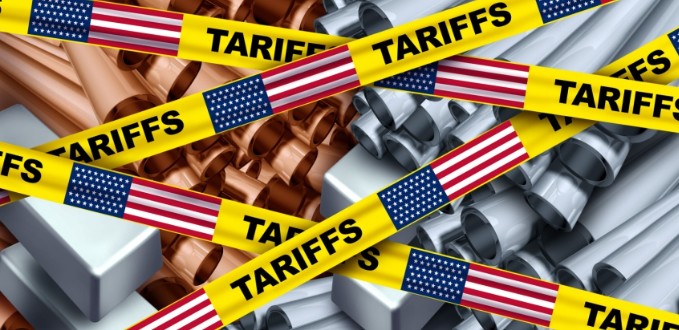Section 232 Tariff Update: What Exporters and Importers Must Know
The U.S. Customs and Border Protection’s newly released guidance (CSMS #65340246) under the Trade Expansion Act Section 232 introduces a major shift: importers must now declare the country of origin for any aluminum or steel used in their products no matter how small or incidental. This applies to:
- Headphones
- Connectors or fasteners made of steel
- Electronics with aluminum heat sinks
If the country of smelt or cast isn’t known, the item must be marked “UN” (unknown), triggering a 200% tariff on the metal content. These rules come into effect on June 28, 2025, and apply to formal and informal entries.
https://content.govdelivery.com/bulletins/gd/USDHSCBP-3e50356?wgt_ref=USDHSCBP_WIDGET_2
Examples of Affected Products
| Product Type | Affected Component(s) |
| Office chairs | Aluminum frames |
| Electronics | Aluminum heat sinks, casings |
| Fasteners & connectors | Steel bolts, screws |
| Kitchen appliances | Steel panels, aluminum handles |
| Automotive parts | Steel brackets, aluminum housings |
| HVAC systems | Aluminum coils, steel ducts |
| Furniture | Welded steel frames |
| Lighting fixtures | Aluminum reflectors |
| Tools & hardware | Steel blades, aluminum grips |
| Medical devices | Aluminum enclosures |
Tariff Impact Examples
Let’s break it down with two companies:
Company A – Office Chair Manufacturer
- Aluminum component value: $40
- Tariff: 200% → $80 added cost
- Total tariffable metal cost: $120
Company B – Electronics Exporter
- Aluminum component value: $25
- Tariff: 200% → $50 added cost
- Total tariffable metal cost: $75
These tariffs are not on the full product only on the declared metal content. But if metal components are misclassified or origins are missing, the cost impact scales rapidly.
Complex BOMs and Layered Supply Chains
For products with deep supply chains like motors or HVAC units origin traceability gets tricky. Take this example:
Electric Motor
- BOM has 200 components
- 100 are steel or aluminum
- Importer must declare origin and value of all 100 parts
- Tariff applies only to those not the full motor
Real-World Import Scenarios
Here’s how that plays out across industries:
Electric Scooter (VoltRide Mobility – Canada)
- Aluminum Frame: China
- Steel Bolts: Vietnam
- Battery Pack: South Korea
- PCBA: Taiwan
- Rubber Tires: Thailand
- Plastic Shells: Malaysia
Tariff applies to aluminum frame + steel bolts only.
Smart Thermostat (EcoTemp Controls – USA)
- 110 parts on BOM
- 45 are steel/aluminum
- Tariff calculated only on those 45
Tractor Subsystem (AgriTorque Systems – Brazil)
- 250 total parts
- 120 metal-based components
Tariff only applies to those 120
Commercial Printer (PrintLogic Solutions – UK)
- Precision aluminum rails + steel tensioners
Tariff only targets declared metal portions
Premium Headphones (SoundNest Audio – Australia)
- 65 total parts
- 18 metal-based
Tariff applies to just those 18 components
Importer Compliance Checklist
Origin Tracking
- [ ] Identify steel/aluminum components
- [ ] Request smelt and cast data from suppliers
- [ ] Avoid “UN” declarations when possible
Documentation
- [ ] Include origin details in POs and packing slips
- [ ] Keep mill certificates or origin statements on file
Supplier Questionnaire Template
1. Component Name:
2. Is it aluminum/steel?
3. % of metal content:
4. Country of smelt:
5. Country of cast:
6. Mill certificate attached? □ Yes □ No
7. Comments:
How Peacock Tariff Consulting Can Help
Peacock Tariff Consulting, founded by Kyle Peacock, provides tailored support to importers through:
Custom compliance systems by product and industry
Strategy for stackable tariffs across jurisdictions
Tariff engineering to reclassify or redesign components
Landed cost forecasts based on multi-regulatory exposure
Audit-ready data models for BOM components
Supplier outreach templates and origin verification protocols
Whether you’re facing a tangled BOM or sudden policy changes, Peacock helps you build transparency, efficiency, and resilience across your supply chain.
Premium Headphones
Say an importer brings in premium headphones with brushed aluminum frames, steel adjustment sliders, PCBA, drivers, foam earpads, and synthetic fabric. Of the 65 total parts, only 18 are metal-based. That’s the slice of the BOM the importer focuses on for duty calculations.
Each of these examples has one thing in common: the devil’s in the detail, and declarations hinge on the material composition not just the final product.
Flow of steel or aluminum parts for headphones produced
North America
USA → Rivets, Driver Magnet Shield
Canada → Shielding Cages (Copper/Steel)
South America
Chile → Internal Wiring Conduits (Copper Tubing)
Europe
Germany → Speaker Diaphragm Ring, Cable Strain Relief Ring, Hinge Mechanism
Austria → Cable Strain Relief Ring (Brass)
Norway → Aluminum Alloy (Speaker Diaphragm Ring)
Sweden → Hinge Mechanism (Metal Alloy)
Asia
China → Headband Frame, Ear Cup Brackets, Mic Housing, Wire Mesh Cover
Taiwan → Adjustment Sliders, Screws, Detachable Clip
India → Audio Jack Housing, Cable Plug Shell
Japan → Speaker Enclosure Ring
South Korea → Heat Sink (Aluminum)
All components shipped via sea or air freight to:
Australia
– Final assembly by SoundNest Audio
– Integration of metal + non-metal parts
– Packaging and quality control
Then imported back into the US for sale to distributor and consumer.
You need to know all of the above or risk the 200% tariffs on cost of each component which can lead to a significant loss to the importer. Take my advice and secure professional help that walk your BOM and Sourcing so you know that you aren’t at risk.

